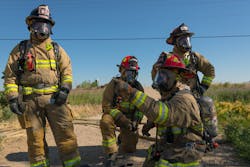The classic movie, “Backdraft,” offers our profession countless one-liners. Maybe the most memorable of them is captured in a very tense moment when Kurt Russell’s character, Stephen McCaffrey, refuses to let go of John “Axe” Adcox, who is played by Scott Glenn, asserting, “You go, we go.” This moment captures the virtue and a fundamental construct of the fire service—that of trust.
Leadership and trust are fundamental elements that represent the best versions of the fire service culture. The harrowing “You go, we go” moment can be applied again and again to leadership and trust in fire service organizations. Having the ability to build an unbreakable trust and rapport with membership has no equal. Leadership only can occur in a climate of mutual, coordinated action that’s based on common values and a common vision. The leader’s task is to unite the group in a familiar, harmonious environment in which each person is free to trust the purposes, actions and intent of the organization.
Building a culture of trust
Building balanced, collaborative fire service teams is indeed a task of leadership. It also is a task to teach a common goal and organizational principles. It’s a process of instilling and encouraging trust. However, the list of organizations that are counted among those that have sound cultures unfortunately isn’t that long. Leadership isn’t dynamic unless there’s a compatible culture, a shared vision and a shared organizational value set. Leadership necessitates that leaders go beyond their personality and technical competence to create a culture that fosters a distinct vision and set of values.
Healthy relationships are built on a foundation of trust. At its most basic level, trust is defined as one party’s willingness to be exposed to the actions of another person or group. It’s a belief that two parties will act in a mutually beneficial manner. For these reasons, effective communication, teamwork, employee commitment and productivity all require trust. These all coalesce to create better working relationships and more positive department culture.
Because trusting relationships are inherently vulnerable, the premise that trust must be earned is accepted widely. Recognizing that trust is a dynamic concept, it is important to understand the different types of trust.Types of trust
There is a growing body of research that’s related to trust in the workplace, and models emerged that help us to understand how it’s built and maintained. One model that’s worth mentioning is from Michelle and Dennis Reina. Their model outlines three critical components: capability trust, character trust and communication trust. Capability trust is a type of competence trust that develops when people have faith in an individual’s perceived level of knowledge, skills and ability. Character trust is rooted in the belief that people will do what they say that they will do and that they can be depended on. Communication trust is defined as the willingness to share information, tell the truth, admit mistakes and keep secrets. Understanding the different types of trust is key, but it also is crucial to understand the various forces that hinder the development of trust.
Forces that hinder
To build trust within a fire service organization, those who are in leadership roles must undertake a difficult and risky task. They must recognize and address potential barriers to harmony and trust if they and the organization are to be successful. The immovable forces within an organization with which we must contend center on individual and organizational constructs that present potential roadblocks. Although definitive solutions aren’t readily available, the underlying message is that recognizing the challenges and minimizing their effect through the leader’s creativity and skills inherently increases trust and, as a result, allows leaders to succeed.
Individual forces
Organizational members communicate information about their feelings, attitudes, problems and ideas every time that they interact with others. That said, it can be dangerous to communicate on so many levels. For better or worse, according to Andrew Van de Ven, who is an organization scholar and the author of “Suggestions for Studying the Strategy Process: A Research Note,” we tend to accept information as accurate or useful to the extent that the sender is perceived to be honest or trustworthy. The converse also is true: Erroneous or deceptive communications can erode trust. This is played out around the kitchen table in every firehouse.
According to Samuel Culbert and John McDonough, who are the authors of “Radical Management: Power Politics and The Pursuit of Trust,” other human tendencies that are related to communication get in the way of trust.
Consider the following example: People dislike subjectivity, because it’s difficult to control. However, much of what we say in life is subjective and isn’t fully supported by objective evidence. Administrators face continual challenges with trust. In the absence of timely or appropriate information-sharing, trust can be jeopardized. Additionally, the same event can be interpreted in a variety of ways by different people.
Perspective changes everything—but it doesn’t change the facts. Leadership shouldn’t make the mistake of assuming that others who are in the organization see the world the same way that they do nor that those others will see the world differently if leaders point it out to them.
To varying degrees, people desire personal agency. When leaders properly allocate and use opportunities to empower others, they are able to harness a powerful tool that can assist an organizational culture to establish or maintain trust. However, some leaders (and followers) are unwilling to share their power. Gerald Griffin, who is the author of “Machiavelli on Management: Playing and Winning the Corporate Power Game,” contends that when leaders or followers disproportionately concentrate power on themselves, a barrier to trust can be created. Power abuse undermines trust relationships.
Some people mistake trust for a simple belief in the goodness of others and the world’s benign nature. These individuals consider those who trust others to be less intelligent and more gullible than they themselves are. They believe that having trusting values lowers a person’s self-worth or potential for success and makes them naive or incapable. This mindset stifles a leader’s ability to succeed.
Trust is earned over time and is the result of a person’s life experiences. Those who have a propensity to trust appear to have more experience with trustworthy others (parents, teachers, bosses and leaders, for example). Trust is a belief in the honesty of a communication, an interaction or a relationship rather than its correctness. When we have a high level of confidence in a person, we usually view them as reliable and trustworthy. Although trust is risky, so, too, is the mantle of leadership. Seen as an opportunity to be vulnerable, leaders must understand and mitigate the risk of trusting others who are in the organization if the leaders are going to be successful.
Although not always beneficial, people have self-serving motives. This is healthy and normal, but it must be recognized and understood. Members of an organization compete with others in social relationships, including work relationships, to achieve personal goals. This competition creates win-lose situations by focusing on individual rather than group action, which can make high-trust relationships difficult. Trust and self-interest are opposed, because the values that support high trust aren’t the same as those that support self-interest.
Organizational forces
The second challenge to trust is created by organizational forces. People’s actions in positions of authority are critical in developing or destroying a trust culture, because their cumulative actions shape the organization’s internal climate in many ways. Leaders can use their power to promote and support a culture that values high levels of trust. In other cases, they use it to create a distrustful atmosphere, whether intending to or not.
The level of authority that’s instilled in an organization’s activity versus the level of self-direction that’s allowed in the relationship between leader and follower appears to be the key to what kind of culture is developed. Leadership’s role in an increasingly complex world should be to structure institutional authority in ways that promote individual growth and group success.
Fire department values are influenced by societal values, reflecting a trend to deconstruct traditional values and morals. Because trust is linked to these and similar values, the decline of fundamental values, such as honesty, integrity, dependability and commitment, can make a leadership team’s efforts to create a trust culture much more difficult. Warren Gamaliel Bennis, who authored “An Invented Life: Reflections on Leadership and Change,” believed that if leaders don’t face this ethical and moral deficit, organizations will end in shambles.
Understanding some of the roadblocks to fire service organizations and individual success can be beneficial. They are unique to individuals or even departments and might have negative or unintended consequences in one organization or one part of the country but not in another. Because they reduce group or individual success, these inadvertent effects could be described as pathological. Other, more general institutional and human barriers to a leader’s ability to instill trust in an organization exist in addition to individual or organizational forces that might obstruct the development of trust. These might include traditionalism, uncontrolled growth, office politics, cynical behavior and employee burnout. Although the effects and presence of these barriers differ depending on the organization, their identification and description appear to be present in all groups to one degree or another.
Trust is foundational
Many people mistakenly define leadership as a function of an individual’s charisma, a collection of behaviors and skills, or a set of optional approaches and contingencies. These ideas aren’t supported by experience. On the other hand, leadership is a collaborative relationship between leaders and their followers. It occurs in situations (organization cultures) in which the leader and the led are united sufficiently in their values and they trust each other to engage in joint activity. Trust is truly more than a construct. It is, in fact, the foundation of the fire service.
About the Author

Kristopher Blume
Kristopher T. Blume is the fire chief of the Meridian, ID, Fire Department and has more than two decades of fire service experience. He is an author, lecturer and independent consultant. Blume is a graduate of the Executive Fire Officer (EFO) program and is an instructor at the National Fire Academy. As a student of the fire service, he is focused on values-driven, mission-focused leadership for the profession. He is the author of "Carry the Fire: The Crucible of Leadership in the Fire Service".

